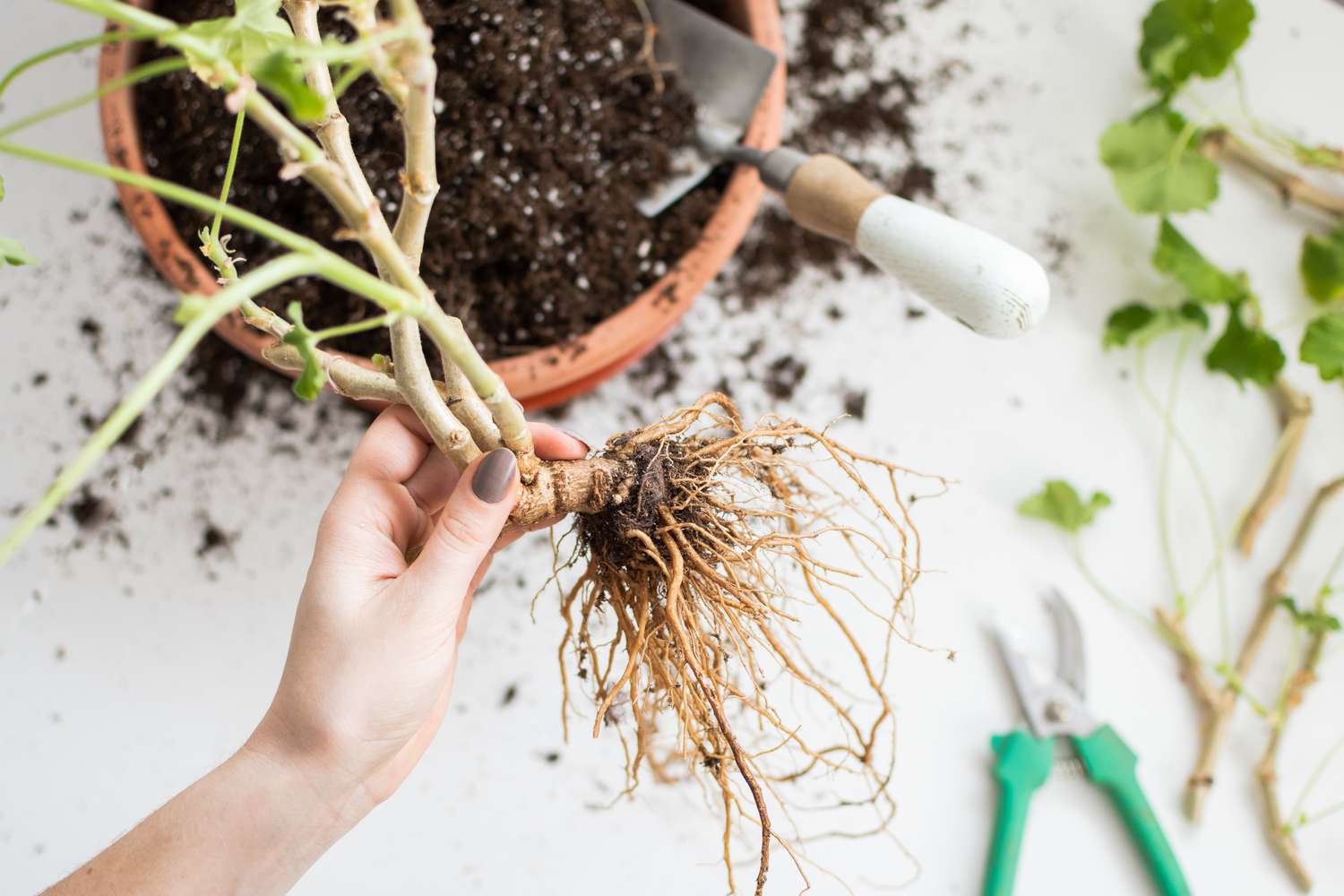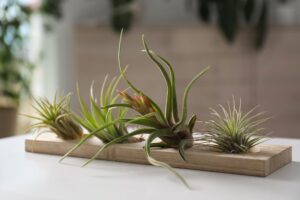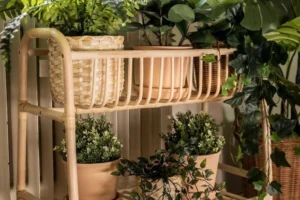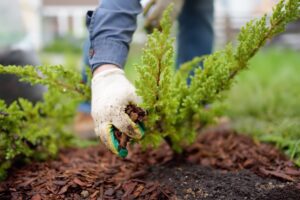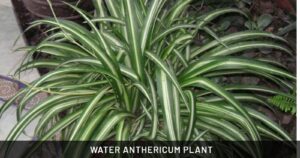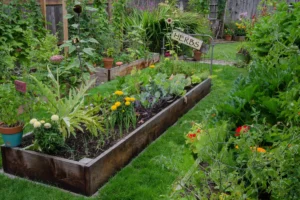Easy Methods for Overwintering Geraniums
As the first frost approaches and temperatures begin to drop, gardeners across the US face an important decision about their beloved geraniums: let them succumb to winter’s chill or preserve them for another season of vibrant blooms? If you’ve invested time and money into your geranium collection, overwintering these beautiful plants is not only economical but also rewarding.
With proper care, geraniums (botanically known as Pelargoniums) can live for several years, becoming larger and more impressive with each passing season. This guide explores various practical methods for overwintering geraniums, helping you choose the approach that best fits your living space, time availability, and gardening expertise.
Why Overwinter Geraniums?
Before diving into methods, let’s consider why overwintering geraniums is worth your effort:
- Cost savings: Purchasing new plants each spring can be expensive, especially for premium varieties
- Preservation of unique cultivars: Keep special varieties that might not be available next year
- Larger plants: Overwintered geraniums often grow bigger and produce more blooms than newly purchased plants
- Sentimental value: Preserve plants with special memories or those received as gifts
- Environmental benefits: Reducing the need for new plastic pots and transportation costs
According to the University of Minnesota Extension, properly overwintered geraniums can grow into impressive specimens that produce significantly more flowers than first-year plants (source).
Understanding Your Geraniums
Before selecting an overwintering method, it’s important to understand which types of geraniums you’re working with.
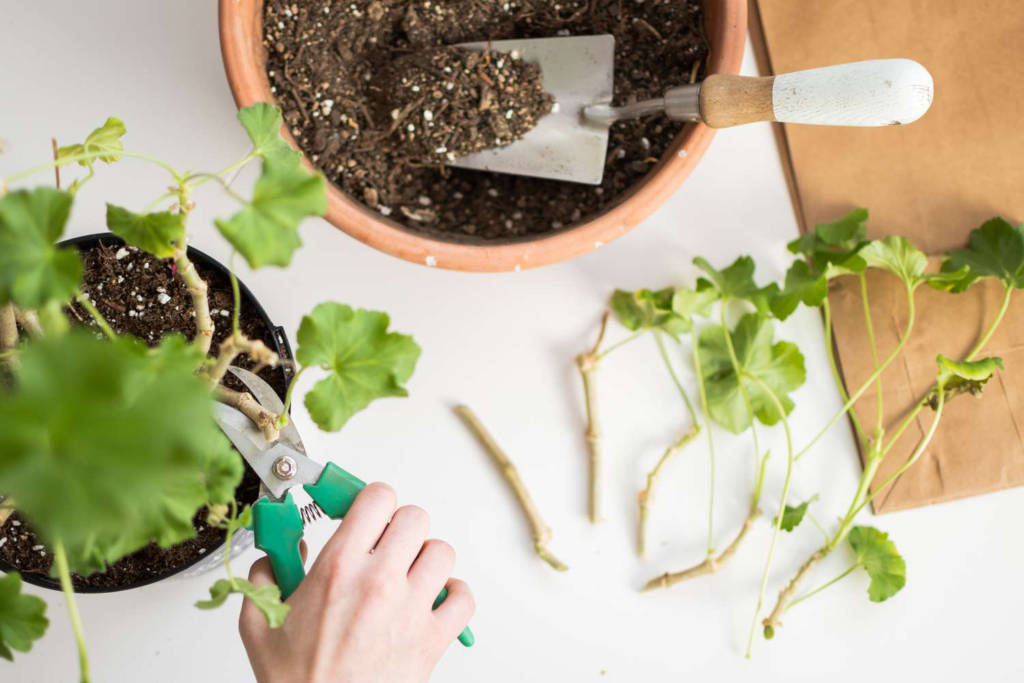
Common Types of Geraniums in US Gardens
| Type | Scientific Name | Characteristics | Best Overwintering Method |
|---|---|---|---|
| Zonal Geraniums | Pelargonium × hortorum | Round leaves with dark “zones” or bands, upright growth | Dormant storage or as houseplants |
| Ivy Geraniums | Pelargonium peltatum | Trailing habit, glossy leaves, good for hanging baskets | As houseplants or cuttings |
| Regal/Martha Washington | Pelargonium × domesticum | Large, showy blooms, less heat tolerant | As houseplants in cool locations |
| Scented Geraniums | Pelargonium spp. | Aromatic foliage in various scents | As houseplants or cuttings |
| True Geraniums (Cranesbill) | Geranium spp. | Hardy perennials, different care needsOften winter-hardy in ground |
It’s worth noting that true geraniums (Geranium spp.) are hardy perennials that often survive winter in the ground in many US growing zones. This article focuses on tender Pelargoniums, commonly called “geraniums” in the US market.
Method 1: Overwintering as Houseplants
This is perhaps the most rewarding method, as you’ll continue to enjoy your plants throughout the winter months.
Preparation Steps:
- Inspect and prune: Examine plants for pests and disease. Remove any dead or damaged foliage and cut back by about one-third to create a more manageable size.
- Potting: If your geraniums are in garden beds, carefully dig them up with as much of the root system intact as possible. Pot them in fresh potting soil in containers with drainage holes. For container plants, consider repotting if they’ve outgrown their current pots.
- Pest treatment: Before bringing indoors, treat for common pests with insecticidal soap or neem oil to prevent introducing problems to your indoor environment.
Indoor Care Guidelines:
- Light: Place in your brightest window, preferably south or west-facing. Geraniums need at least 6-8 hours of bright light daily. Consider supplementing with grow lights during darker winter months.
- Temperature: Maintain temperatures between 65-70°F (18-21°C) during the day and slightly cooler at night.
- Watering: Reduce watering significantly compared to summer care. Allow the soil to dry out between waterings, typically every 7-10 days depending on your home’s humidity levels.
- Fertilizing: Feed sparingly during winter – once a month with a half-strength balanced fertilizer will suffice.
- Humidity: Geraniums tolerate dry indoor conditions well, making them ideal houseplants during heating season.
The National Gardening Association recommends rotating plants weekly to ensure even growth, as geraniums will naturally lean toward light sources (source).
Method 2: Dormant Bare Root Storage
If you lack sunny windowsills or space for potted plants, storing geraniums in their dormant state is an excellent alternative that requires minimal space.
Step-by-Step Process:
- Timing: Implement this method before the first killing frost, usually when nighttime temperatures consistently dip below 40°F (4°C).
- Dig up plants: Carefully remove plants from the garden, gently shaking off excess soil from roots.
- Prepare for storage: For each plant:
- Remove all leaves
- Cut stems back to 6-8 inches
- Shake off as much soil as possible without damaging roots
- Storage options:
- Paper bag method: Place bare-root plants in paper bags or wrap in newspaper
- Hanging method: Tie string around the roots and hang plants upside down
- Box method: Place plants in a cardboard box lined with newspaper
- Storage location: Keep in a cool (40-50°F/4-10°C), dark area such as a basement, garage, or cellar. The USDA recommends checking periodically for mold or rot and removing affected portions (source).
- Maintenance: Check monthly and lightly mist roots if they appear extremely dry, but avoid excess moisture which can cause rot.
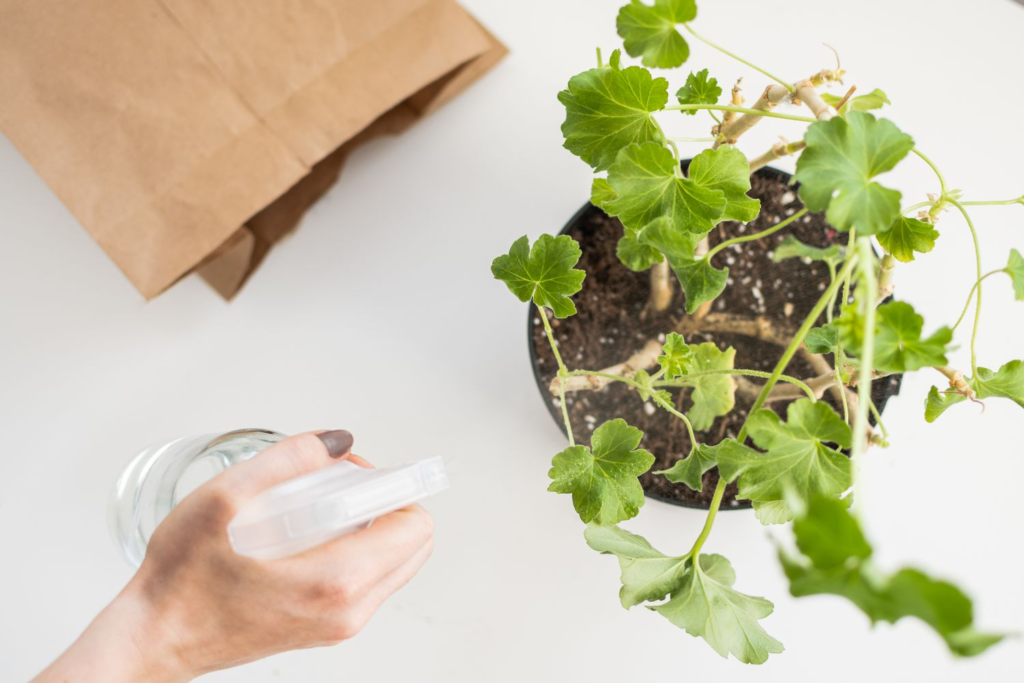
Reviving Dormant Plants:
Approximately 6-8 weeks before your last spring frost date:
- Pot up dormant plants in fresh potting soil
- Water thoroughly once
- Place in a bright location but not direct sunlight
- Begin normal watering only after you see new growth
- Gradually reintroduce to outdoor conditions after danger of frost
Method 3: Taking and Rooting Cuttings
This space-efficient method allows you to preserve your geranium genetics without keeping entire plants. It’s ideal if you have limited indoor space but want to maintain your collection.
Cutting Preparation:
- Timing: Take cuttings in late summer to early fall, before bringing plants indoors.
- Selection: Choose healthy, non-flowering stems with 3-4 leaf nodes.
- Cutting technique:
- Cut stems to 4-6 inches long
- Make cuts just below a node (where leaves attach to stem)
- Remove lower leaves, keeping only 2-3 sets at the top
- Allow cut ends to callus (dry) for 12-24 hours
- Rooting medium: Use a 50/50 mix of perlite and vermiculite, or a commercial seed-starting mix.
- Rooting process:
- Dip cutting ends in rooting hormone (optional but beneficial)
- Insert into pre-moistened rooting medium
- Water lightly and place in bright, indirect light
- Maintain humidity with a clear plastic cover or bag, leaving space for air circulation
- Care during rooting: Keep soil lightly moist but not soggy. Roots typically develop in 3-6 weeks.
According to research from Clemson University Cooperative Extension, success rates for geranium cuttings can exceed 90% when proper humidity and temperature conditions are maintained (source).
Overwintering the Rooted Cuttings:
Once rooted (when gentle resistance is felt when tugging on the cutting):
- Transfer to 3-4 inch pots with regular potting soil
- Grow as houseplants following the care guidelines in Method 1
- Pinch growing tips to encourage bushier growth
- Transplant to outdoor containers or garden beds after danger of frost has passed
Method 4: Cool Storage in Containers
This method combines elements of dormant storage while keeping plants potted, requiring less space than growing as houseplants but more than bare-root storage.
Implementation:
- Preparation: Before first frost, cut plants back by about one-third and remove any dead or yellowing leaves.
- Inspection: Check thoroughly for pests and treat if necessary.
- Watering adjustment: Gradually reduce watering frequency in the weeks before bringing plants indoors.
- Storage conditions:
- Place potted plants in a cool location (40-50°F/4-10°C)
- Areas with minimal light are acceptable
- Good ventilation is important to prevent mold
- Water very sparingly (once every 4-6 weeks) – just enough to prevent complete drying
- Spring revival: About 6-8 weeks before last frost:
- Move to a brighter location
- Begin regular watering as new growth appears
- Repot if necessary with fresh potting soil
- Gradually acclimate to outdoor conditions
The Pennsylvania State University Extension notes that this method often results in leggy spring growth that benefits from pruning to encourage bushiness (source).

Choosing the Right Method for Your Situation
Consider these factors when deciding which overwintering approach works best for you:
Space Considerations:
- Limited space: Choose bare root storage or cuttings
- Bright windows available: Grow as houseplants
- Cool basement or garage: Use dormant storage or cool container storage
Time Investment:
- Low maintenance needed: Bare root or cool storage methods
- Enjoy continuing care: Houseplant method
- Limited time in fall: Taking cuttings is quick with less digging
Climate Factors:
- Mild winters (USDA zones 9-10): Geraniums may survive outdoors with protection
- Cold winters: Indoor methods essential
- Very dry indoor heating: Cuttings or dormant storage may be easier than houseplants
Preparing for Spring: Transitioning Overwintered Plants Outdoors
Regardless of which method you choose, proper spring transition is crucial for success:
- Timing: Begin transition after the danger of frost has passed for your region
- Gradual acclimation: “Harden off” plants by gradually introducing them to outdoor conditions:
- Start with 1-2 hours of filtered sunlight
- Increase exposure by 1-2 hours daily
- Bring plants in at night initially
- Complete the hardening process over 7-10 days
- Pruning and shaping: Once plants show active growth, prune to encourage bushiness and remove any remaining leggy growth from winter
- Fertilization: Begin regular feeding schedule with a balanced fertilizer once plants are established outdoors
- Planting options:
- Return to garden beds after soil has warmed
- Use in container arrangements
- Create hanging baskets with trailing varieties
The Missouri Botanical Garden recommends refreshing potting soil annually, even for plants kept in the same containers, to provide fresh nutrients and prevent soil compaction (source).
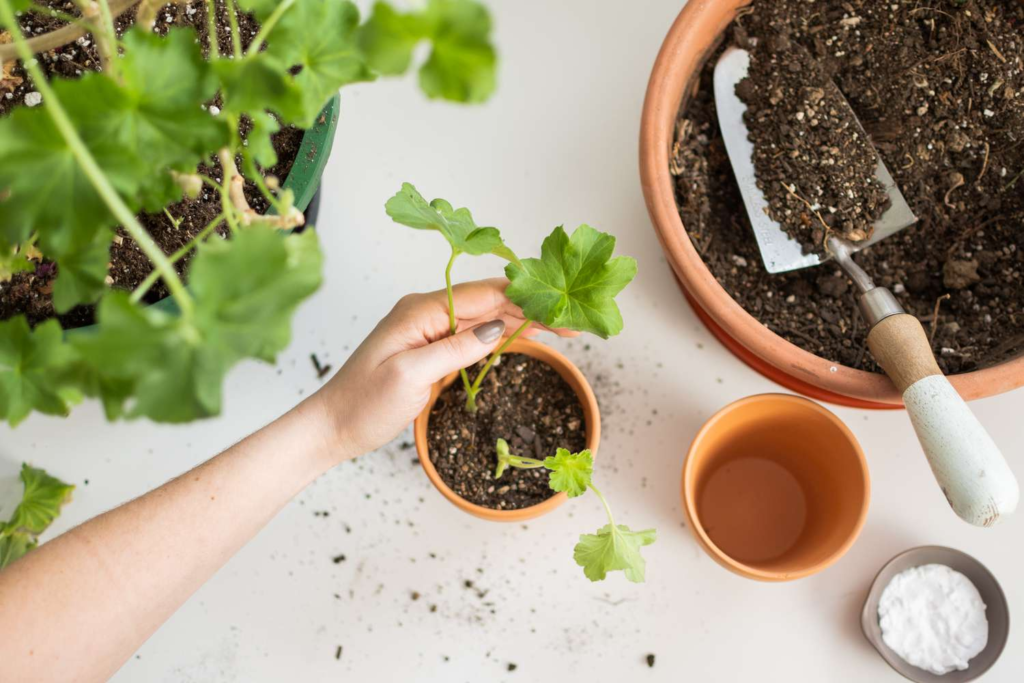
Common Problems and Troubleshooting
Even with careful attention, overwintered geraniums can develop issues. Here’s how to address them:
Leggy Growth:
- Cause: Insufficient light during winter storage
- Solution: Provide supplemental lighting or accept the need for spring pruning
Pest Infestations:
- Common pests: Aphids, whiteflies, spider mites
- Prevention: Inspect regularly, especially undersides of leaves
- Treatment: Insecticidal soap, neem oil, or wiping with alcohol for light infestations
Leaf Drop:
- Cause: Usually shock from environmental change or overwatering
- Solution: Stabilize conditions and adjust watering; some leaf drop during transition is normal
Rot or Mold:
- Cause: Excessive moisture, especially in dormant storage
- Solution: Improve ventilation, reduce watering, remove affected areas
Failure to Bloom After Overwintering:
- Cause: Insufficient light or nutrients
- Solution: Ensure adequate sunlight and begin fertilization when active growth resumes
Conclusion: Enjoying Years of Beautiful Geraniums
With these overwintering techniques, you can preserve your favorite geraniums for years to come, saving money while enjoying larger, more productive plants each season. Many gardeners find that third or fourth-year geraniums develop almost shrub-like qualities with impressive flower displays that far surpass newly purchased plants.
Whether you choose to keep plants growing indoors through winter, store them dormant, or propagate through cuttings, the extra effort pays dividends in garden beauty and personal satisfaction. Each method has its advantages, and many experienced gardeners use a combination of approaches to maximize success and minimize risk.
By understanding the needs of your geraniums during their winter rest period, you’re setting the stage for a spectacular display when warm weather returns. Your overwintered geraniums will reward your care with vigorous growth and abundant blooms, becoming cherished elements in your garden design for years to come.
For additional information on geranium care throughout the seasons, visit the USDA’s National Agricultural Library resources at https://www.nal.usda.gov/collections/gardening-resources.
